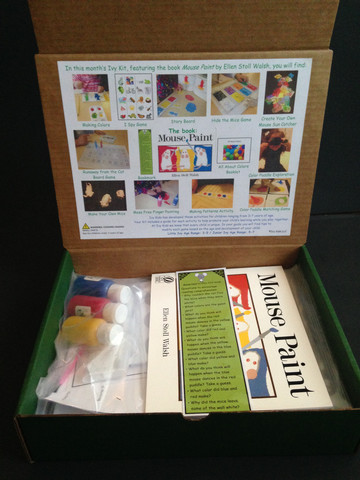We all know that young children thrive on hands-on activities, and we also know that connecting activities to story books makes it even more fun. But it’s a lot of work to plan and organize this type of learning. So Ivy Kids produces monthly educational boxes that put it all together for you by including almost everything you’ll need for activities across the curriculum as well as some activities just for fun. Children receive their kit in the mail each month, and this will likely be an exciting event for most children.
Kits are designed primarily to develop math literacy, school readiness, pre-reading skills, critical thinking skills, fine motor skills, communication and vocabulary skills, and sometimes even large motor skills. Each kit is suitable for children ages three through about eight. Instructions for each activity are generally given at two levels: Little Ivy for children ages three through five and Junior Ivy for children five through eight. Even though some activities and their variations address the needs of older children, I think these kits are ideal for four and five year olds.
Each box includes a children’s picture book that provides the theme for the entire kit. For example, the book Jump, Frog, Jump! by Robert Kalan is the basis for a kit on frogs. Eleven activities come in the kit, each packaged with its instructions and components. You rarely need anything else since kits even include scissors and glue. (We found that the glue included with this kit wasn’t strong enough for assembling the “Make Your Own Frog” kid and ended up using our own glue instead.) Sometimes resources are used in more than one activity, and often there are additional variations to try. In the Frogs box, examples of activities are:
- creating a mini-booklet “All About Frogs”
- creating a frog habitat on blue paper plate--sand, play dough, plastic frogs, and insects are all included
- playing “Lily Pad Scatter Jump” as children jump from lily pad to lily pad (all of different colors) as a parent calls the colors
- play “Letter Jump” with the letter game board and jumping plastic frogs to practice identifying letters and sounds
- playing “Race to the Pond Game” with a small game board by rolling one dice—practice number recognition, counting, and one-to-one correspondence
- story telling with “Story Stick Puppets”
- “Feed the Frog” game that helps children work on small motor control
Another box uses the book Chicka Chicka Boom Boom by Bill Martin Jr. and John Archambault, a story that begins, “A told B, and B told C, ‘I’ll meet you at the top of the coconut tree.’” This silly alphabet story provides the palm tree theme for the box. Children make their own palm tree, work on tracing letters and numbers, learn “All About Palm Trees” from a mini booklet, play “ABC Palm Tree Bingo,” and complete a coconut observation sheet with a real half of a coconut shell.
Each kit includes an item that is personalized with the child’s name. For example, the Frog kit has a frog door knob hanger with your child’s name prominently in the middle. The Palm Tree kit has a laminated sheet with the child’s name in large dotted letters for tracing practice.
A sheet affixed to the inside of the box lid serves as your guide to each month’s activities at a glance with full-color illustrations of completed projects. Each box then has a number of zip-locked bags with instructions and components for each activity. They are generally organized with resources for each activity in one bag, but as I mentioned before, some resources are used for more than one activity.
While you might be able to complete a number of the activities in one day, the idea is that you will spread them out over the month, re-reading the story as you please. There’s no set progression on the activities—choose what suits you for each session. Some craft projects will be one-time activities. But if a child enjoys a particular game, they will probably want to do it over and over again. You can also revisit some of the activities trying some of the suggested variations.
You can subscribe for one month, three months, or six months. If you have more than one child at this level, you will want to pay the minimal $5 per month cost for an extra set of supplies. Some kits from past months are still available in the Ivy-Kids online store, so you might want to check if there is a kit there with a particularly appealing topic.
Ivy Kids is a very creative and practical way to teach preschoolers that is developmentally appropriate. There is plenty of multi-sensory learning and interaction, but the kits make it easy by doing the planning, gathering, and preparation work for you.








